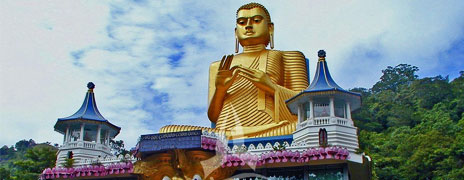The Neighbours

India bristles with an eclectic mélange of ethnic groups; an intoxicating cultural cocktail for the traveller.
Sri Lanka has seduced travellers for centuries. Marco Polo described it as the finest island of its size in the world, while successive waves of Indian, Arab and European traders and adventurers flocked to its palm-fringed shores, attracted by reports of rare spices, precious stones and magnificent elephants. Sri Lanka has eight World Heritage Sites packed into such a small area. Its 2000-plus years of culture can be discovered at ancient sites filled with mystery. Legendary temples boast beautiful details crafted by artisans through the centuries. Safari tours of Sri Lanka’s pleasantly relaxed national parks encounter leopards, grouchy water buffaloes, all manner of birds and a passel of primates. When you’re ready to escape the tropical climate of the coast and lowlands, head for the hills, which are verdant, virescent and virally infectious with allure. Impossibly green tea plantations and rainforested peaks beckon walkers, trekkers or just those who want to see it on a spectacular train ride. The beaches! Dazzlingly white and all so often untrod, they ring the island so that no matter where you go, you’ll be near a sandy gem. Should you beat the inevitable languor, you can surf and dive world-class sites without world-class crowds. Distances are short: see the sacred home of the world’s oldest living tree in the morning (Anuradhapura) and stand awestruck by the sight of hundreds of elephants gathering in the afternoon (Minneriya). Find a favourite beach to call your own, meditate in a 2000-year-old temple, exchange smiles while strolling a mellow village, marvel at birds and wildflowers, try to keep count of the little dishes that come with your rice and curry. Stroll past colonial gems in Colombo and then hit some epic surf. Sri Lanka is spectacular, it’s affordable and it’s still mostly uncrowded. Now is the best time to discover it.
Wedged between the high wall of the Himalaya and the steamy jungles of the Indian plains, Nepal is a land of snow peaks and Sherpas, yaks and yetis, monasteries and mantras.Trekkers are drawn to the Himalaya’s most iconic and accessible hiking, some of the world’s best, with rugged trails to Everest, the Annapurnas and beyond. Nepal is nirvana for mountain lovers. Adventure seekers are drawn here by the adrenaline rush of rafting down a roaring Nepali river or bungee jumping into a bottomless Himalayan gorge. Canyoning, climbing, kayaking, paragliding and mountain biking all offer a rush against the backdrop of some of the world’s most dramatic landscapes.
Nepal can also be seen at a more gentle pace, admiring the peaks from a Himalayan viewpoint, strolling through the temple-lined medieval city squares of Kathmandu, Patan and Bhaktapur and joining Buddhist pilgrims on a spiritual stroll around the centuries-old stupas and temples that lie scattered across the Kathmandu Valley.Nepal’s wild and woolly national parks in the South, where nature buffss scan the treetops for exotic bird species and comb the jungles for rhinos and tigers from the backs of lumbering Indian elephants. Nepal offers an astonishingly diverse array of attractions and landscapes.
Nepal can also be seen at a more gentle pace, admiring the peaks from a Himalayan viewpoint, strolling through the temple-lined medieval city squares of Kathmandu, Patan and Bhaktapur and joining Buddhist pilgrims on a spiritual stroll around the centuries-old stupas and temples that lie scattered across the Kathmandu Valley.Nepal’s wild and woolly national parks in the South, where nature buffss scan the treetops for exotic bird species and comb the jungles for rhinos and tigers from the backs of lumbering Indian elephants. Nepal offers an astonishingly diverse array of attractions and landscapes.
If any country in the world can lay claim to the word unique, it’s the Himalayan mountain kingdom of Bhutan. Bhutan, the Land of the Thunder Dragon, is no ordinary place. First off there are the early Buddhist sites in the cultural heartland of Bumthang Dzongkhag and the undisturbed traditional Tibetan-style culture that sets Bhutan aside as the last remaining great Himalayan kingdom. Then there are the textiles, outrageous trekking as well as the stunning flora and fauna of Phobjika Valley. Trashigang is an interesting town and also useful for launching into a trip in Eastern Bhutan.It is also a country of surprises. This is not just a nation of saintly, other-worldly hermits. Bhutan is straddling the ancient and modern world and these days you’ll find monks transcribing ancient Buddhist texts into computers as traditionally dressed noblemen chat on their mobile phones. It is not only the “Lost Shangri La,” but it also is “The Last Shangri La.”
Contemplate the 4000 sacred stupas scattered across the plains of Bagan. Stare in disbelief at the Golden Rock teetering impossibly on the edge of a chasm. Ride a horse cart past colonial-era mansions. Meet multitalented monks who have taught their cats to jump, or feisty elderly Chin women, their faces tattooed with intricate designs. Drift down the Ayeyarwady in an old river steamer; stake out a slice of beach on the blissful Bay of Bengal or trek through pine forests to minority villages scattered across the Shan Hills. Dig into the myriad dishes of the local cuisine, from a hearty bowl of mohinga noodles for breakfast to the fermented tea-leaf mixture that’s a popular finish to a Burmese meal. One of the most fascinating aspects of travel in Myanmar is the opportunity to experience a corner of Asia that, in many ways, has changed little since British colonial times .‘This is Burma’, wrote Rudyard Kipling. ‘It is quite unlike any place you know about.’ More than a century later Myanmar remains a world apart.